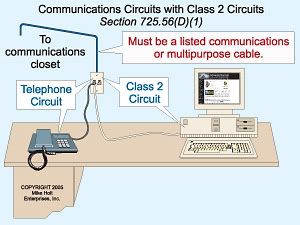erickench
Senior Member
- Location
- Brooklyn, NY
Does anyone know if the installation of ethernet cables such as category 5E are covered by NEC 725?
Eric,
That article you cited appears to be talking about Power Over Ethernet. I had one that said that the Ethernet cables were an Article 725 installation even where they do not power equipment. It was posted here, but I have not looked for it in some time.
The code is not completely clear on this. There are "experts" that say 725 is the governing article and others that say it is 800. I don't know of anyone who says 830 applies to Ethernet cables.

Found a graphic

I think one of the criteria is what the wire is used for, the application. Using cat 5 for power monitoring or power control equipment comm. is clearly article 725. Using the same cat 5 in a different application could be article 800.
Good luck with the job app.
I think one of the criteria is what the wire is used for, the application.
These meters all have ethernet, RS-232/485 ports for connection to cables. For the immediate connection to these meters would NEC 725 or NEC 800 apply?
What the cable plugs into.
800.18, communications equipment shall be listed in accordance with 800.170 as telcom equipment.
725.1, If the cable plugs into power monitoring equipment, it is on the load side of power distribution equipment. There is some mixing of power, class 1, class 2, class 3, associated with the utilization of the equipment. There is a lot more going on with the equipment beyond solely communication. Is the equipment listed as telcom only or listed as power supply and distribution with an accessory communication and control feature ?
There is some overlap between 725 and 800. Outside comm circuits look definitely art 800. I'm looking for the reference, I recall something about if an art 725 building control wire shared a cable tray with art 800 comm circuits, art 800 would apply.
There are layers to the comm network. Base layer, the power monitoring devices communicate to other same system devices, multiplexors, routers, traffic switches, and run stand alone on a PC in the Windows operating system. Next layer is system integration into a BAS, building automation system, running over that network for display on a PC in the BAS software as a software module . The BAS is a lot of art 725 class 2 running everywhere, controlling motors, receiving alarms. There is some standard ip network protocol comm paths over cat 5, with web browser access, however they should be air gapped to the other building network cabling for security purposes. Anyone with a web browser, web address, password, could gain full access to the BAS.
The point where the cat 5 plugs into primarily power distribution equipment with a monitoring device feature, that I would say is art 725. The protocol could be standard ip and the data packets may travel successfully over a widespread ip network. The point where the cable carrying that data packet traffic plugs into solely listed per 800.170 telcom equipment, routers, that could well be art 800 cabling.
